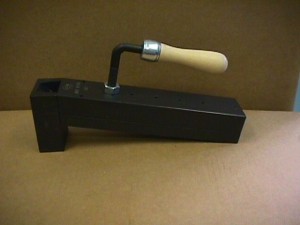K-Mold Inclusion Sampler – Foundry Floor Level Aluminum Melt Quality Test
The K-Mold Inclusion Sampler is made of Cold Rolled Steel that is Black Oxided with a wooden handle and various bolts.
The K-Mold aluminum melt quality test is a fracture test that was developed by researchers at Nippon Light Metals, and is presently specified, both as a melt qualification test on incoming raw materials, and as a process control tool in casting operations of Japanese owned foundries. The shape of the test piece is a flat plate, as opposed to a found test coupon, and is interrupted by four knife edges on the cope side of the plate. These edges serve both as fracture plane surfaces, and also as collectors to concentrate inclusion matter present in the molten sample being evaluated. While the geometry of the shape is quite simple, there are many subtleties in the design which influence the efficiency of the mold to produce clear and readable indications.
In use, multiple samples of the plate are poured from the metal being evaluated, and are fractured immediately by the technician performing the test. Those fracture surfaces containing inclusions are considered to be an “event” and are expressed as a ratio of events to sound surfaces. For example, if two bad fractures are found in a total of twenty fractures, the ratio is 2/20 = 0.1.
Allowable ratios are established for each product family, with those demanding a higher level of metal purity specifying a lower level of “K-Value”. Typically, a thin walled casting that has pressure tightness requirements may require maximum values of 0.05 (a maximum of one inclusion in twenty fractures). Heavier walled castings with less critical requirements may be produced to higher K-Values.
While certainly not a perfect test the use of the K-Mold does seem to answer many of the needs of the industry for a method of melt quality evaluation. The results produced are at least semi-quantitative, are quickly available for corrective action to be taken on the shop floor, and may be performed by a person with minimum level of training and experience. The drawbacks lie principally in the limited volume of material actually being sampled, and the possible sensitivity of the test to operator technique.
Contact us today if you would like more information on our K-Mold Aluminum Melt Quality Test.


